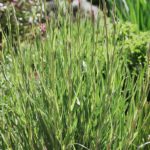Eat sweet peppers raw in salads, or eat them steamed, stir-fried, roasted, grilled or roasted, or stuffed. Use them in casseroles or rice dishes.
Sweet peppers are in season from late spring through late summer.

Types of sweet peppers
Sweet peppers are warm-season annuals in temperate regions and perennials in tropical climates. Sweet peppers are herbaceous plants that usually become woody at the stem base. They grow from 6 to 48 inches (15-122cm) tall depending upon the variety. They are multi-branched with smooth oval to lance-like, deep-green leaves 2 to 4 inches (5-10 cm) long.
Sweet peppers range in color from pale to dark green, from yellow to orange to red, and from purple to brown to black. They can be a solid color or variegated.
Kitchen Helpers from Amazon:
- EZ Off Jar Opener for Weak Hands
- Pepper Core Remover Stainless Steel
- Kitchen Utensils – Set of 35
- Rachel Ray Non-Stick Cookware 12pcs
The juicy flesh of sweet peppers can be thick or thin and the flavor can range from bland to sweet to bittersweet.
The fruits or pods of sweet peppers are edible. The pod of the bell pepper has four lobes and is somewhat square in shape. Some sweet peppers have three lobes and some are tapered in shape with no lobes at all.
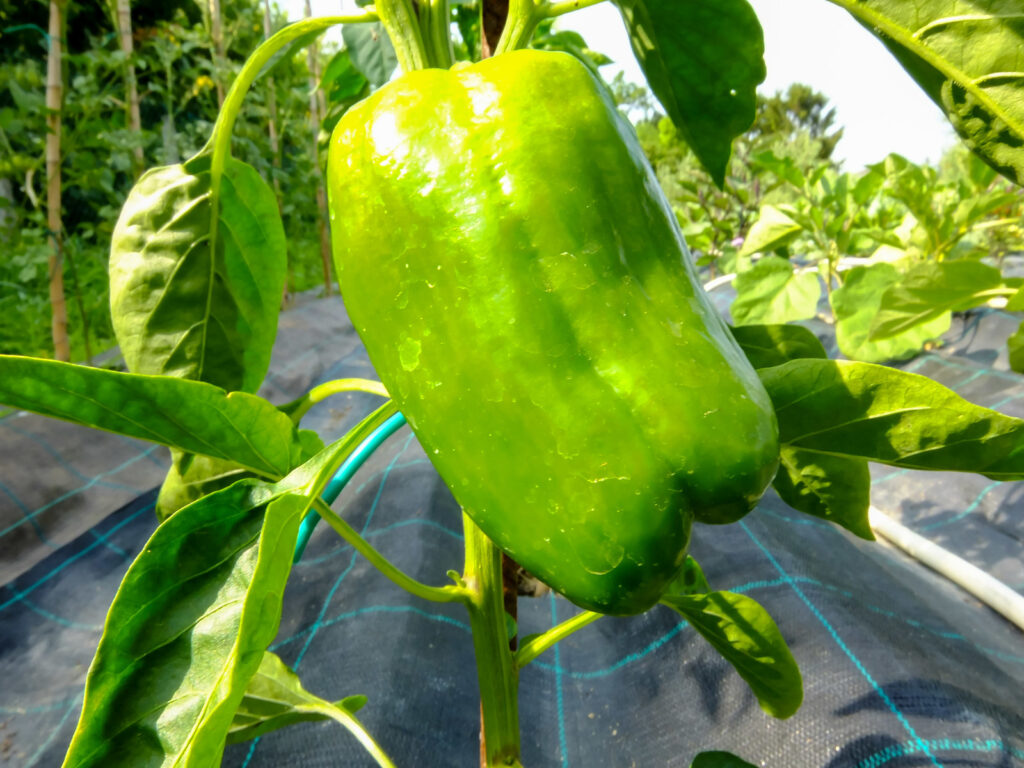
Popular sweet peppers
- Bell peppers are the best-known and most widely available sweet peppers. Bell peppers can vary from 3½ to 5½ inches (9-14 cm) long and from 2½ to 4 inches (6.4-10 cm) wide. Bell peppers get their name from their bell-like shape. Bell peppers have a mild, sweet flavor and crisp juicy flesh. They are usually bright green, but they also can be yellow, orange, purple, red, and brown. If a bell pepper is red, it has been vine-ripened. Red bell peppers are sweeter tasting than green bell peppers.
- Bull’s Horn is a long, narrow, sickle-shaped green pepper with a pointed tip that turns from green to yellow to red in late summer.
- Cubanelle—also called Cuban pepper is a long (about 4 inches/10 cm), tapered yellow to red pepper with thick meaty walls that are more flavorful than the bell pepper.
- Lamuyo–also called European sweet pepper or rouge royal pepper is a very sweet, bell-shaped pepper that is longer and larger and more slender than the standard bell pepper with thick flesh.
- Pimiento is a large, heart-shaped pepper with thick, meaty flesh that is excellent for roasting and peeling.
- Sweet Banana is a long, banana-shaped yellow pepper good to stuff or pickle.
How to choose a sweet pepper
- Select sweet peppers that are firm, glossy, and plump with no blemishes or soft spots.
- Select brightly colored peppers.
- Peppers that are heavy for their size will have thick, meaty walls.
- Avoid peppers that are shriveled or have soft spots.
- If a pepper is green, it was harvested before it ripened. A green pepper will turn yellow and red as it matures. Purple, brown, and black peppers will become green as they ripen.
- Peppers that ripen on the plant will be sweeter and more fragrant than those that don’t. Red and orange peppers are the sweetest.
How to store sweet peppers
- Unwashed sweet peppers will keep in a perforated plastic bag in the refrigerator for up to 1 week or in a cool, dry spot for up to 2 weeks. Store peppers whole rather than sliced.
- If blanched or roasted and peeled, peppers will keep in the freezer for up to 6 months. Dried peppers will keep for up to 1 year.
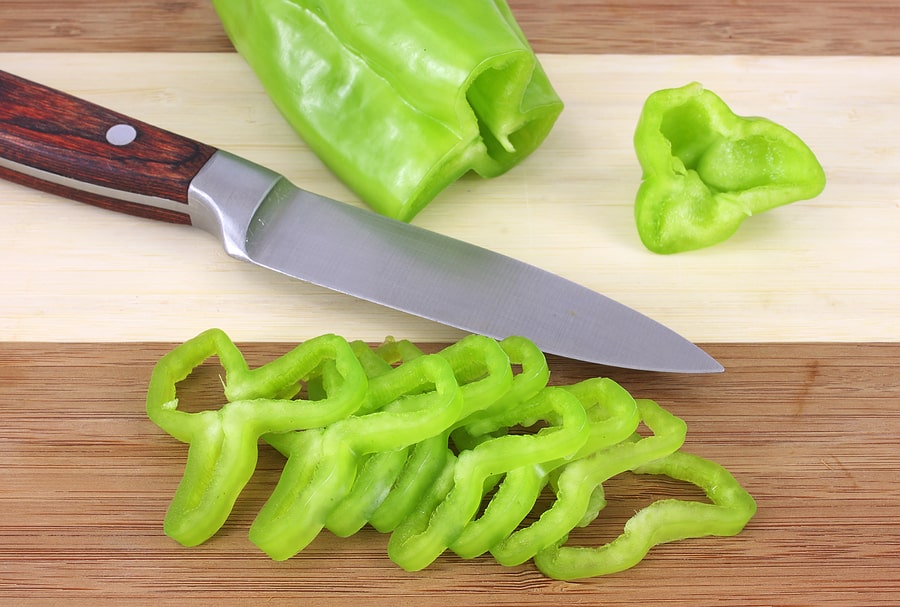
How to prep sweet peppers
- Cut sweet peppers into slices, strips, or pieces. Remove the stem, the core, and the seeds before cutting.
- Cut sweet peppers crosswise for rings and lengthwise for julienne strips or diced cubes.
- For stuffing, parboil the whole pepper for 3 to 5 minutes then refresh in cold water for 5 minutes.
- To peel a pepper, first, bake the whole pepper in a preheated oven at 350º F (176º C) for 5 to 8 minutes; place the baked pepper in a paper or plastic bag and seal; let sit for about 15 minutes; remove, slice and remove the seeds; peel off the skin with your fingers.
- To stuff a pepper, make a cut around the stem and remove it, or cut about ¼ or ½ inch (6-13 mm) off the top; pare out the seeds and core and any whitish veins; fill the cored pepper with stuffing and replace the top. To shorten the cooking time, blanch the pepper in advance.
Sweet pepper cooking suggestions
- Use raw slices or diced peppers to add color and flavor to vegetable platters and salads or to garnish casseroles and soups.
- Simmer pepper pieces for 3 to 7 minutes.
- Steam pieces or cored whole peppers for 5 to 10 minutes depending upon the thickness of the walls.
- Sauté or stir-dry pepper pieces without coating or batter for 4 to 9 minutes or long enough to soften.
- Sauté sweet pepper strips in olive oil with onions and garlic, sprinkle with vinegar and chill. There you have a tasty weekend salad. But wait! You can use this same mix to top hot Italian sausages.
- Pan-fry or deep-fat fry pepper slices in a wet or dipped batter until the crust is golden brown.
- Bake whole stuffed peppers until the stuffing is browned.
- Peppers become sweet when cooked. Don’t overcook peppers; they will lose flavor and nutrients.
- Cooking will cause brown, black, and purple peppers to become green.
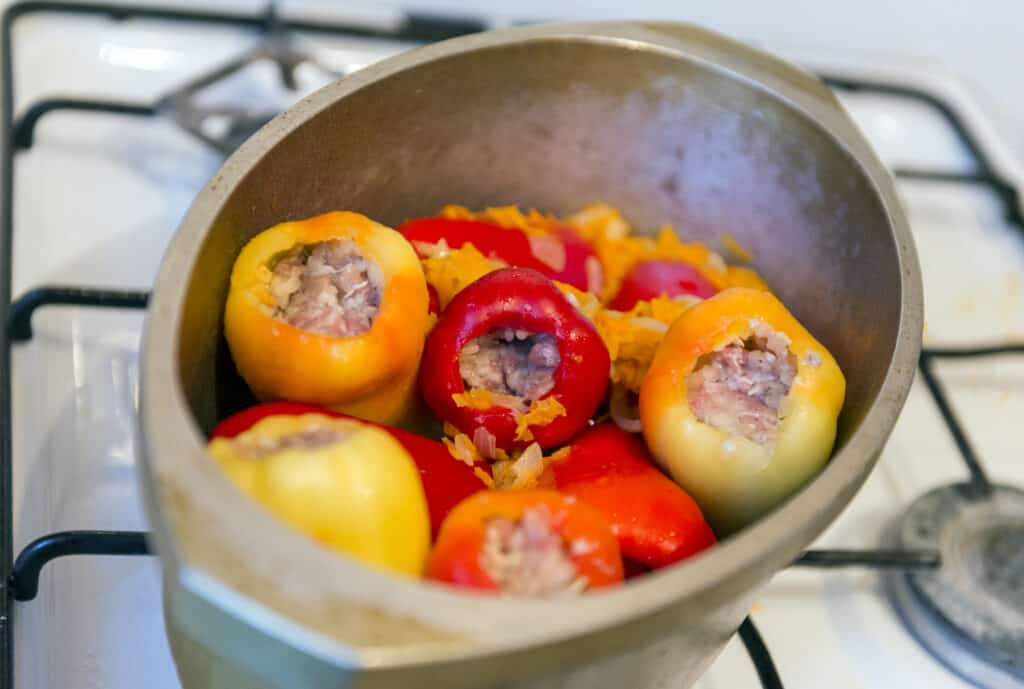
How to steam sweet peppers
Steam whole bell peppers for stuffing, or steam pieces of peppers for a side dish.
- Cut out the stem and seeds.
- Place whole peppers upright in a steaming basket or place cut pieces in the basket. Be sure the water below the basket does not touch the peppers.
- Bring the water to a boil over medium heat; cover and steam until the peppers are just tender, about 4 to 10 minutes depending on the size of the peppers.
- Whole peppers can be stuffed with rice, chopped vegetables, seasoning, and cheese.
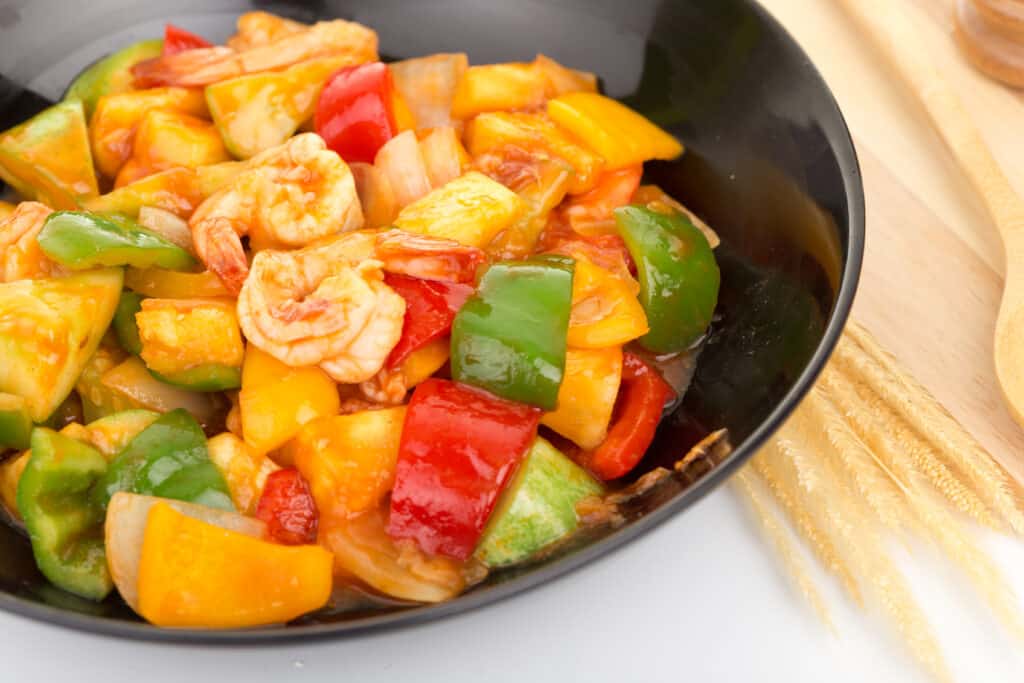
How to sauté (stir-fry) sweet peppers
- Cut the pepper into small pieces.
- Heat a small amount of oil over medium heat in a heavy skillet.
- Add pepper pieces and stir occasionally so the pieces cook evenly.
- Add flavorings such as chopped onions, minced garlic, freshly ground black peppers, or a few teaspoons of lemon or lime juice.
- Cook until the peppers become tender, about 8 to 10 minutes.
Add other vegetables such as onions and mushrooms just after the peppers if you like.

How to roast sweet peppers
- Brush the peppers with a light coat of vegetable oil.
- Place the peppers on a broiler in the oven.
- Turn the peppers as they broil to brown them evenly, about 5 to 8 minutes.
- When they are charred, place the peppers inside either a plastic resealable or brown paper bag for 15 minutes before peeling off the outer charred layer.
- Cut up the peppers as desired based on how you plan to use them.
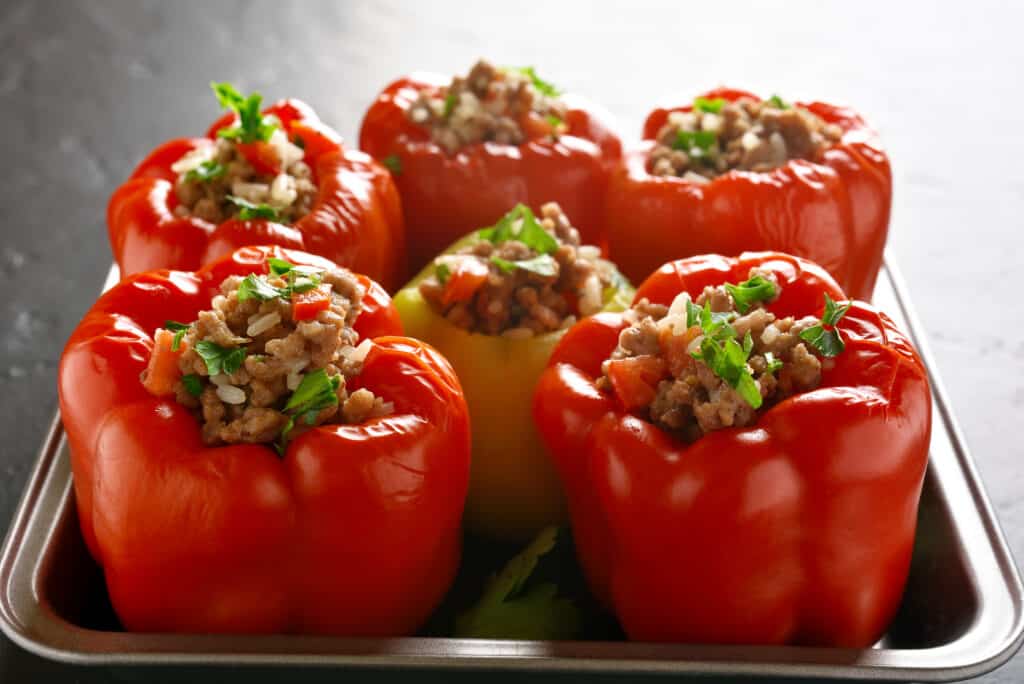
How to stuff sweet peppers
- Remove the tops, seeds, and membranes from the peppers.
- Blanch the peppers in boiling water for 3 to 4 minutes.
- Drain the peppers and make a few small holes in the bottom with the point of a small knife.
- Preheat the oven to 375 degrees F.
- Stuff the peppers with rice, corn kernels, fish, sausage, or leftover vegetables.
- Arrange in a baking dish, add 1 cup of stock, and bake for about 25 to 30 minutes.
- Serve hot.

How to prepare a Cubanelle sweet pepper
The cubanelle sweet pepper is tasty lightly roasted and served on a summer sandwich or green salad.
Core and seed three or four of the long tapered cubanelles and place them on the grill or about five inches below the oven broiler element and cook until the skins blister and char on each side, about 10 minutes per side. Next, place the peppers in a large sheet of aluminum foil and leave until they are no longer hot; now, you slice and remove the ribs and seeds and peel the skins away and arrange these colorful peppers to their best effect.
(Tasty tip: an hour before roasting, place the peppers in a glass bowl with a couple of tablespoons of olive oil, 3 or 4 sprigs of thyme, and salt and pepper to taste. Turn the peppers every 15 minutes so they will be evenly coated with oil.)
Ok, if that sounds like too much work, the mild and colorful cubanelle can be sliced raw right onto a green salad and topped with a vinaigrette. Or slice up some cubanelles to add to fresh salsa.
Cubanelles are mild to spicy, less so with cooking. You’ll find the flavor of the cubanelle akin to the popular Anaheim sweet pepper. Cubanelles range in color from green to yellow to red. A red cubanelle is a ripe pepper but not necessarily spicier than a green cubanelle. When it comes to hot, be assured the Cubanelle barely rates on the Scoville unit pepper heat meter.
Cubanelles are also known as Italian frying peppers. They are popular in Italy added to casseroles and pizzas.
Cubanelles can be stuffed after roasting whole, without coring and seeding beforehand: follow the roasting directions above, slice and seed the peppers after roasting, and then lightly stuff with a mix of goat cheese, fresh crushed garlic to taste, olive oil, and a bit of fresh minced thyme. Once the cheese mixture is added to the sliced peppers, reheat them in the oven or on the grill for a few minutes.
Sweet pepper serving suggestions
- Eat sweet peppers raw or cooked.
- Eat raw served with dips or as an appetizer or in salads.
- Use sweet peppers in braises, casseroles, tomato sauces, or as a stuffed casserole. Add sweet peppers to soups, omelets, tofu, stews, brochettes, rice, pasta, and pizza. Use sweet peppers in gazpacho, peperade, ratatouille, or in marinades.
- Stuff sweet peppers with tuna, chicken, a rice and meat mixture, or chili con carne. Stuff them with rice and chopped vegetables, a cheese mixture, or seasoned bread crumbs.
- Slice sweet peppers into rings, and serve in a salad. Use thick rings in a dish of vegetables for tempura. French-fry peppers or fry them Italian-style in oil and garlic.
- Serve sautéd peppers with freshly cut kernels from corn on the cob or with Italian sausages.
- Sauté strips of sweet peppers and serve as a side dish or garnish for braised cod or lamb.
- Roast and peel sweet peppers and serve as a salad with lemon and oil.
- Dip pepper strips in tempura batter and fry.
- Add bell peppers strips to stir-fries.
Sweet pepper flavor partners
- Sweet peppers have a flavor affinity for beans, beef, celery, cheese, chicken, eggplant, eggs, garlic, ham, hot chile pepper, lettuce, onions, peas, pork, rabbit, sausage, tomato, tuna, and zucchini.
- Season sweet peppers with salt, pepper, onion, garlic, basil, coriander, cumin, mustard, turmeric, curry powder, oregano, or parsley.
- Top sweet peppers with plain or flavored butter or margarine, vinaigrette dressings, or tomato sauce.
Sweet pepper nutrition
- Sweet peppers contain vitamins A and C and are a good source of potassium.
- The nutritional value is the same for raw and cooked peppers.
Canning peppers
Beginner’s Guide to Canning Peppers
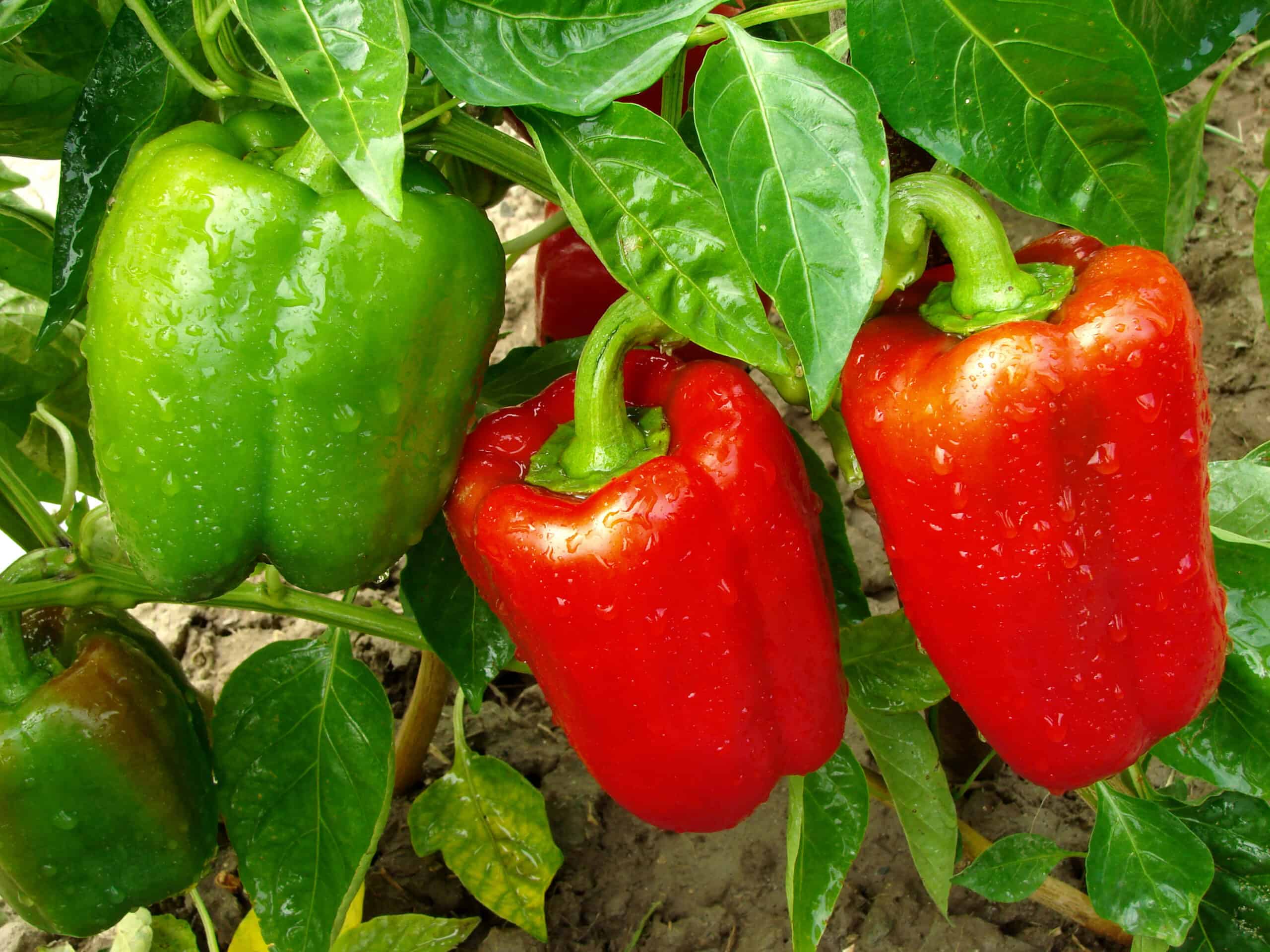
Get to know sweet peppers
- In the United States, mild-tasting peppers are known as sweet peppers, and hot-tasting peppers are known as hot peppers or chiles.
- In England, all peppers are called chiles but hot-tasting peppers are called hot chiles.
- In Latin America, hot peppers are called chiles, and mild peppers are called pimientos. But in the United States, pimientos are one variety of sweet red pepper.
- The sweet pepper and the hot pepper come from the same wild species. Peppers originated in the New World tropics and West Indies. Peppers were one of the first plants cultivated in South America sometime around 5,000 B.C. Spanish and Portuguese explorers took peppers to Europe and from there, their cultivation expanded.
The botanical name for sweet peppers is Capsicum annum.
Pepper articles at Harvest to Table:
How to Grow Sweet Bell Peppers
How to Plant and Grow Hot Chili Peppers
Six Tips to Grow Peppers for Flavor
7 Tips for Growing Peppers in Pots
How to Harvest and Store Peppers
Five Ways to Cook and Serve Sweet Peppers
Five Ways to Cook and Serve Chili Peppers
Beginner’s Guide to Canning Peppers
Pepper Growing Problems Troubleshooting
Epsom Salt, Milk, and Organic Fertilizers for Tomatoes and Peppers
How to Prevent Blossom Drop — Tomatoes and Peppers
Garden Planning Books at Amazon:
- Vegetable Garden Grower’s Guide
- Tomato Grower’s Answer Book
- Vegetable Garden Almanac & Planner
- Kitchen Garden Grower’s Guide Vegetable Encyclopedia
More kitchen tips:
Bring your harvest to the table. Kitchen prep tips and easy recipes for the vegetables you grow. Click below for vegetable prep and recipes you can use now.
- Almonds
- Apples
- Apricot
- Aprium
- Artichoke
- Arugula
- Asparagus
- Avocado
- Bamboo Shoots
- Banana
- Basil
- Beans, Dried
- Beans. Long
- Beans, Shell
- Beans, Snap
- Beets
- Bitter Melon
- Blackberry
- Bok Choy
- Broccoli
- Broccoli Raab
- Brussels Sprouts
- Cabbage
- Cardoon
- Carrots
- Cauliflower
- Celeriac
- Celery
- Chard
- Chayote Squash
- Cherimoya
- Cherries
- Chestnut
- Chickpea
- Chinese Cabbage
- Chives
- Cilantro
- Citron
- Clementine
- Collards
- Coriander
- Corn, Sweet
- Corn, Baby
- Corn Salad, Mache
- Cranberry
- Cress
- Cucumber
- Daikon
- Dandelion
- Dill
- Eggplant
- Endive, Belgian
- Endive and Escarole
- Fava Beans
- Fig
- Florence Fennel
- Garlic
- Ginger
- Grapefruit
- Grapes
- Guava
- Horseradish
- Jerusalem Artichoke
- Jicama
- Jujube
- Kale
- Kiwifruit
- Kohlrabi
- Kumquat
- Leeks
- Lemongrass
- Lemons
- Lettuce
- Lime
- Mache (Corn Salad)
- Mandarin Orange
- Mango
- Maple Syrup
- Marjoram
- Melons
- Michihili
- Mint
- Mizuna
- Mushrooms
- Mushrooms, Cremini
- Mustard Greens
- Napa Cabbage
- Nectarine
- Okra
- Olives
- Olive oil
- Onions
- Oranges
- Oregano
- Parsley
- Parsley Root
- Parsnips
- Passion Fruit
- Pawpaw
- Peaches
- Pears
- Peas, Garden Snap
- Peas, Snow
- Pei Tsai
- Peppers, Chili
- Peppers, Sweet
- Persimmon
- Pineapple
- Pineapple Guava
- Plantain
- Plums
- Pluots
- Pomegranate
- Potatoes
- Prickly Pear
- Pumpkin
- Quince
- Radicchio
- Radishes
- Raspberries
- Rosemary
- Rhubarb
- Rutabaga
- Sage
- Salsify
- Sauerkraut
- Savory
- Shallots
- Sorrel
- Spinach
- Squash, Summer
- Squash, Winter
- Strawberries
- Sunchokes
- Sunflower
- Sweet Potato
- Swiss Chard
- Tangerine
- Taro
- Tarragon
- Thyme
- Tomatillo
- Tomato
- Turnip
- Turnip Greens
- Yams














